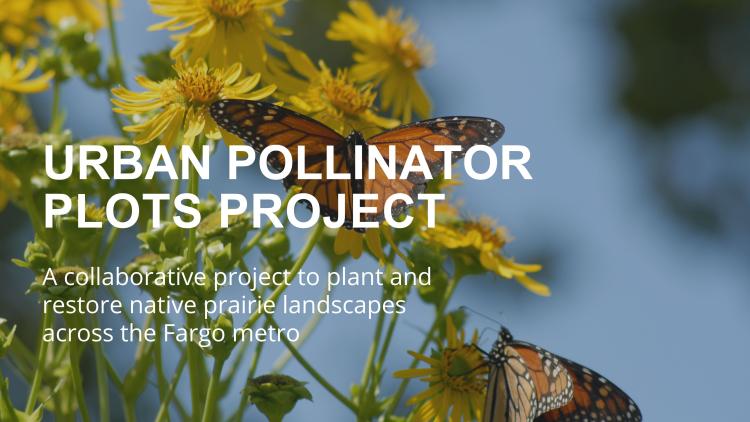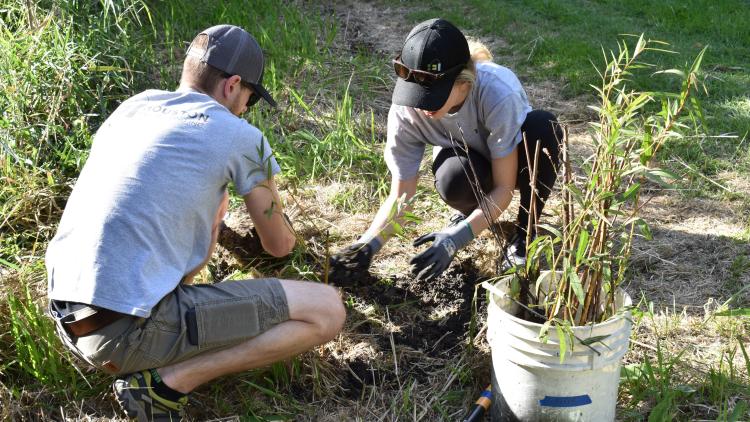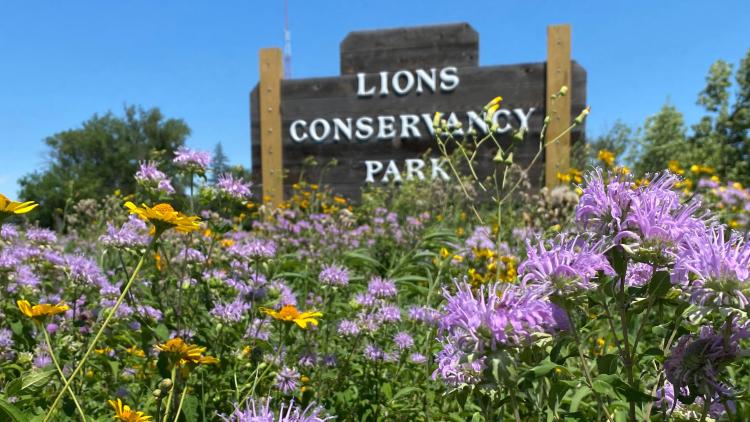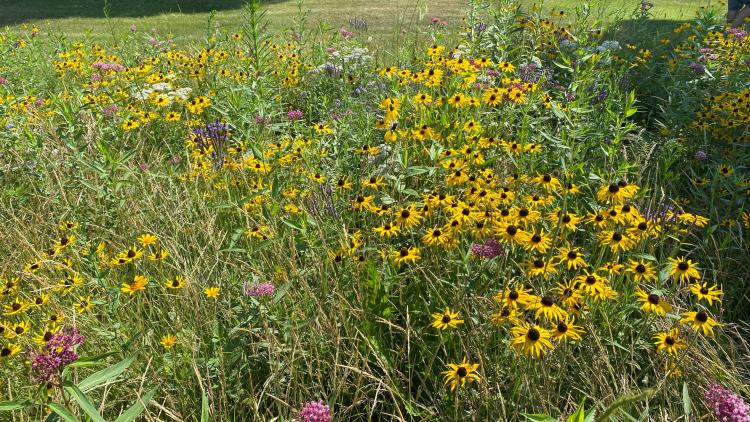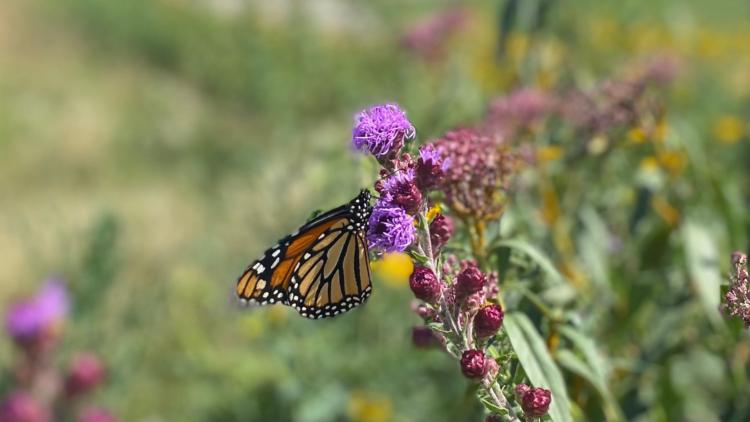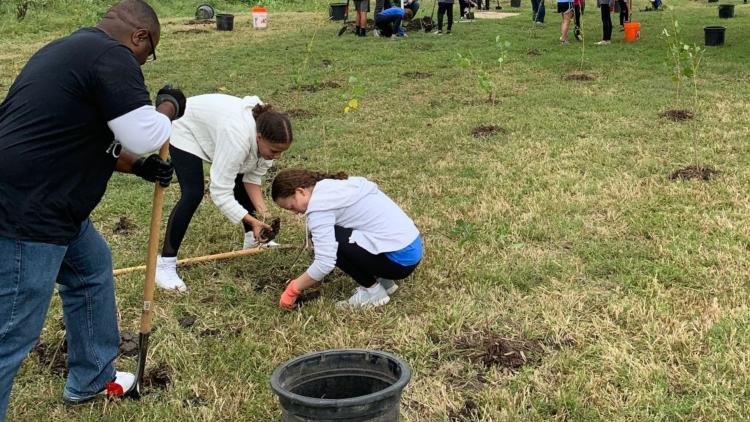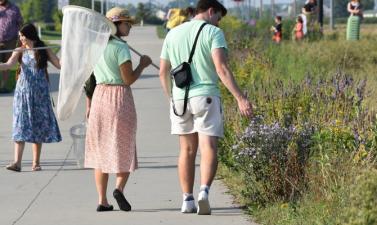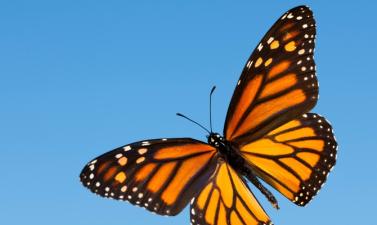The Urban Pollinator Plots (UPP) Project is a collaborative effort between the Fargo Park District, Audubon Great Plains, North Dakota State University, United Prairie Foundation and the North Dakota Outdoor Heritage Fund to establish and restore native urban landscapes that are beneficial to pollinators across the Fargo metro.
With the goal of establishing more than 50 acres of high diversity, forb-rich, native prairie plantings in urban parklands, the UPP Project hopes to beautify the community we call home and increase awareness and education on the importance of protecting our natural resources.
Read more details about the project, upcoming events, volunteer opportunities and more below. We're so happy you're here and can't wait to continue this important work with you!
FAQs
Pollinators need prairies AND prairies need pollinators!
Did you know that tall-grass prairie once covered roughly the entire eastern one-fourth of North Dakota? Unfortunately, over 72% of our native prairies have been converted to other uses such as cropland, urban expansion and energy development.
With the loss of prairies comes a sharp decline in grassland birds, insect pollinators and other critters important to the health and vitality of our natural spaces.
The spaces that are established and restored as part of the UPP Project will serve as wildlife and pollinator protection areas, community gathering spaces and peaceful nature reserves to get away from the hustle and bustle of the city.
After careful consideration, UPP Project partners and organizers selected space in six Fargo Parks as locations to plant and maintain small urban pollinator gardens and tracts of native prairie.
- North Softball Complex - 25 acres
- Mickelson Fields - 6.5 acres
- Golden Valley Park - 2.75 acres
- Eagle Valley Park - 2.2 acres
- Forest River Park - 5 acres
- Orchard Glen - 3.75 acres
The following species of plants will be planted in gardens across the community:
- Alumroot
- Bedstraw
- Bergamot
- Big Bluestem
- Black-eyed Susan
- Blanket Flower
- Blue Vervain
- Boneset
- Bottle Gentian
- Canada Anemone
- Canada Milk Vetch
- Canada Wildrye
- Cinquefoil
- Common Milkweed
- Cordgrass
- Culvers Root
- Cup Plant
- Dotted Liatris
- Downey Gentian
- Flat Top Aster
- Flodman’s Thistle
- Four Flower Loosestrife
- Fringed Brome
- Giant Sunflower
- Golden Alexander
- Golden Aster
- Golden Ragwort
- Great Blue Lobelia
- Green Coneflower
- Green Needle Grass
- Ground Plum
- Harebell
- Hawkweed
- Heath Aster
- Hoary Vervain
- Hookers Oats
- Hyssop
- Indian Grass
- Ironweed
- Joe Pye Weed
- June Grass
- Kalm’s Brome
- Large Beardtongue
- Lead Plant
- Little Bluestem
- Long Headed Coneflower
- Marsh Muhly
- Maximillian Sunflower
- Meadow Liatris
- Meadow Rue
- Mountain Mint
- Narrow Leaf Coneflower
- Narrow Leaf Goldenrod
- Narrow Leaf Milkweed
- New England Aster
- Nuttails Sunflower
- Old Field Goldenrod
- Onion
- Oxeye Sunflower
- Pasque Flower
- Prairie Dropseed
- Prairie Liatris
- Prairie Lily
- Prairie Phlox
- Prenanthes Rattlesnake Root
- Purple Prairie Clover
- Purple Stem Aster
- Riddell’s Goldenrod
- Rose
- Rough Dropseed
- Rough Liatris
- Saw Toothed Sunflower
- Scribner’s Panic Grass
- Scurf Pea
- Showy Goldenrod
- Showy Milkweed
- Showy Sunflower
- Showy Tick Trefoil
- Side Oats Gramma
- Silky Aster
- Silky Prairie Clover
- Sky Blue Aster
- Slender Wheatgrass
- Smooth Blue Aster
- Sneezeweed
- Spiderwort
- Stiff Goldenrod
- Swamp Milkweed
- Switch Grass
- Thimbleweed
- White Bottle Gentian
- White Goldenrod
- White Prairie Clover
- White Sage
- Whorled Milkweed
- Yarrow
Pollinators are hard-working animals and insects that fertilize plants, resulting in the formation of seeds and the fruit surrounding seeds. Pollinators help pollinate over 75% of our flowering plants and nearly 75% of our crops. Read below about a few our favorite pollinators that will directly benefit from the UPP Project:
- Bees and Wasps are maybe the most important pollinators in the world North Dakota is home to so many bee and wasp species we can't even count them all! But it's estimated that there are hundreds.
- Butterflies and Moths might be the most beautiful pollinators with patterned and often brightly colored wings. About 150 species of butterflies and more than 1,400 species of moths call North Dakota home!
- Birds are critical in wildflower pollination and contribute heavily to the overall health of prairie land. The UPP Project will provide critical habitat to grassland birds, including North Dakota's state bird, the Western Meadowlark.
All wildlife will benefit from native prairie planting. The prairie plants attract insects which provide food for many upland birds, such as grouse, prairie chickens, pheasants and partridge. Also, many small mammals rely on insects for food. The prairie also provides nesting, bedding and sanctuary cover from many animals including turkeys and deer.
Woody encroachment is a problem in many grassland habitats throughout the U.S. and numerous studies have shown how restoration can be thwarted when woody plants are left unmanaged in grassland landscapes. Often, one particularly invasive woody species will take over a grassland patch, dramatically reducing plant diversity.
A crucial part of the UPPP is to establish sites that will promote the longevity of prairie plantings, and showcase the diversity of flowering forbs within grassland ecosystems to support pollinators in our area. This cannot be done, however, when there are trees, shrubs, and snags overtaking former grassland habitats.
The Urban Pollinator Plots Project is following the "gold standard" for prairie establishment, which involves eliminating weeds, planting a soybean cover crop and then broadcasting native seeds the following spring.
Read more about the process of establishing a resilient urban prairie here.
We could not do this important work without the support and help from YOU, our community!
There are many ways you can get involved with the UPP Project.
Join us for for a Monarch Butterfly Tagging Event on August 17
Join Audubon Great Plains and the Fargo Park District for an evening of community science and wonder at a Monarch Tagging Event on Thursday, August 17 from 5:00 to 7:00 PM at Urban Plains Parks, 3020 51st Street S, Fargo.
Attendees will have the unique opportunity to get up close and personal with Monarch Butterflies through butterfly tagging.
The event is free, does not require pre-registration and is open to the entire community.
Volunteer Opportunities:
If you are interested in volunteering individually or as a group for this project or others like it, please reach out directly to Sam DeMarais at sdemarais@fargoparks.com and Meghan Carter at Meghan.Carter@Audubon.org.
Educate
A really easy way to help is to share the news with your friends and family. Tell them about the project and all you've learned about the importance of pollinators and native prairies! A huge part of the UPP Project is to educate the community and you could play a big part in that.
You can! In fact, creating a native prairie or pollinator garden at your home is one of the best ways you can support our local North Dakota pollinators and "bee" a part of something big. There's many resources online, but our favorites are below:
Cass County Soil Conservation District - Pollinator Habitat Brochure

